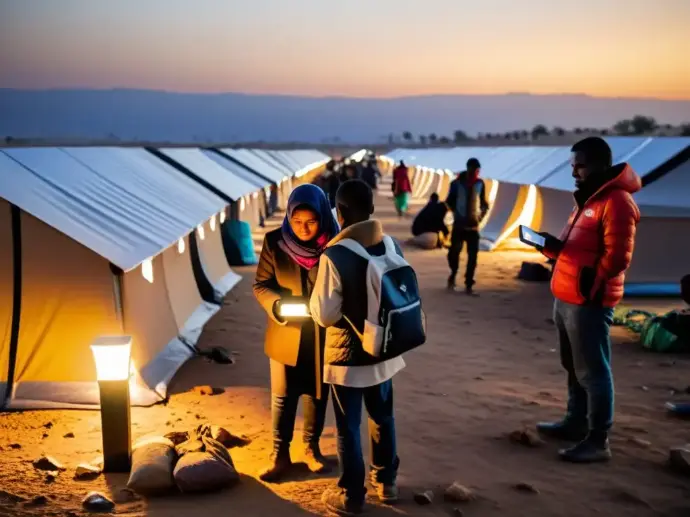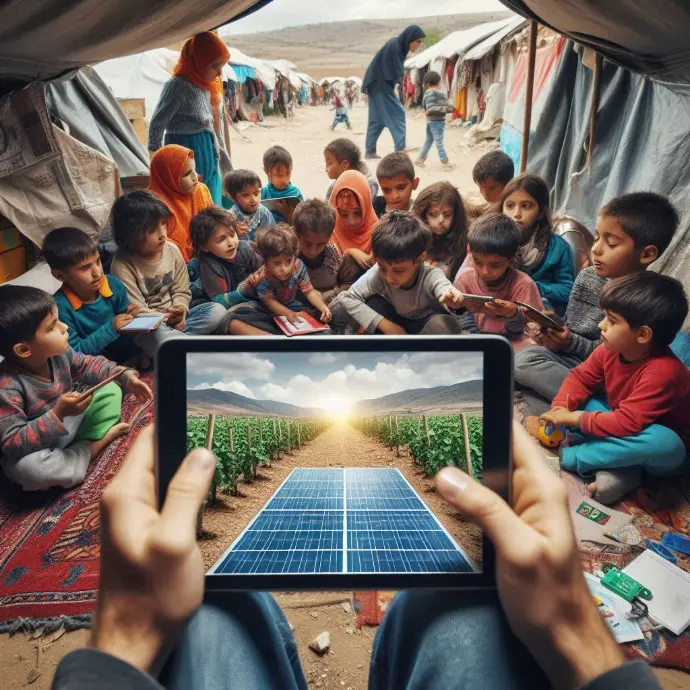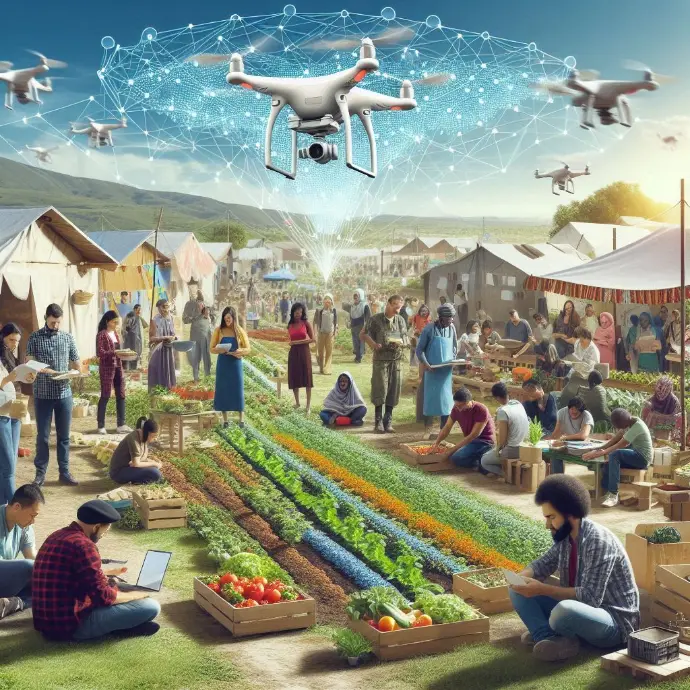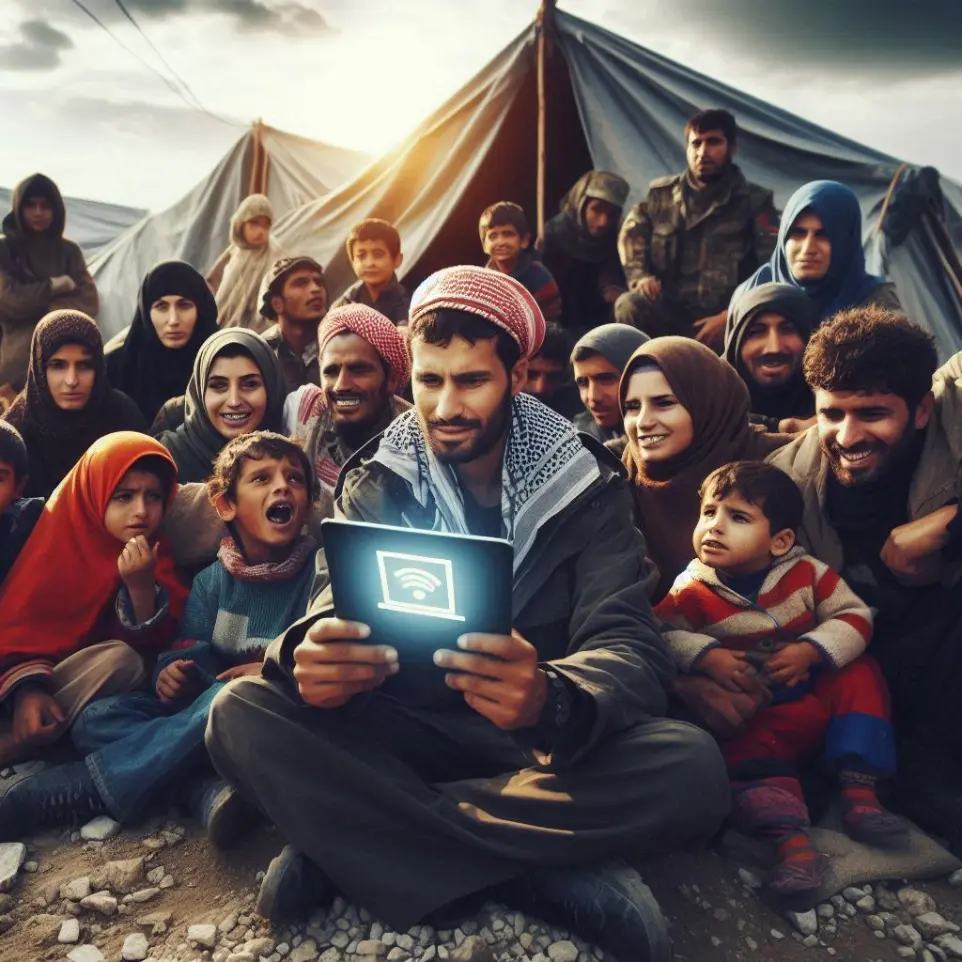
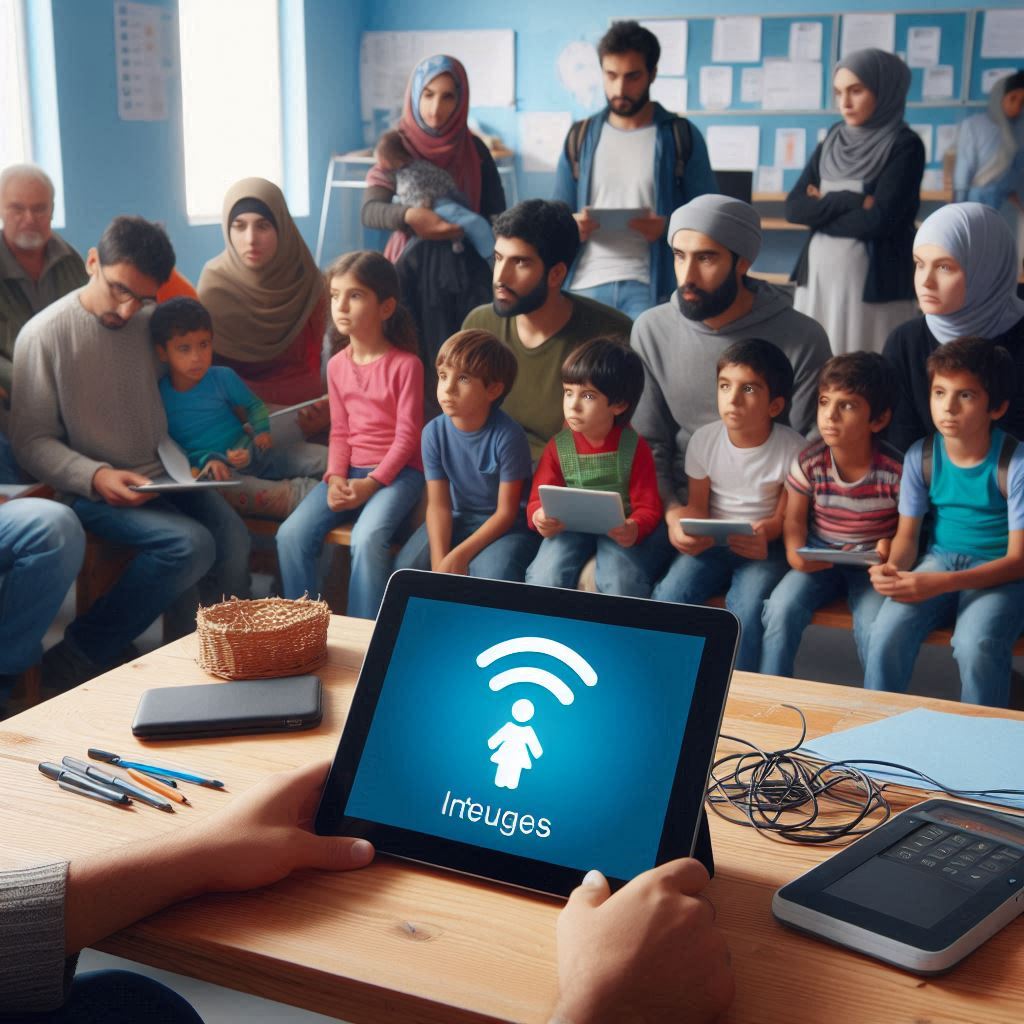
Technology to the Rescue: Innovations to Improve the Lives of Refugees
Here you will find a space dedicated to an in-depth exploration of human rights at a global level. In our last article, “Technology to the Rescue: Innovations to Improve the Lives of Refugees,” we looked at technological innovations that are positively impacting the lives of refugees around the world. Would you like to discover how technology is being used to improve the living conditions of displaced people? Go ahead and join us in this fascinating exploration of technological innovations for refugees and their impact on today’s world!
Introduction
Humanitarian crises, such as armed conflict, natural disasters and political persecution, have a devastating impact on the lives of millions of refugees around the world. These situations result in forced displacement, loss of homes, separation of families and limited access to basic resources such as food, shelter and healthcare. Refugees face extremely difficult conditions and often struggle to rebuild their lives in unfamiliar and hostile environments.
The lack of stability and security, coupled with scarce resources, contributes to the vulnerability of refugees, who often face the risk of exploitation, abuse and violence. The need for innovative and sustainable solutions to address the challenges faced by refugees is increasingly pressing, and this is where technology plays a crucial role in seeking significant improvements in their living conditions.
Technological innovation offers the promise of providing practical and effective solutions to address the urgent needs of refugees, from humanitarian assistance to the protection of their fundamental rights. Through advancements in areas such as connectivity, sustainable energy, health, education and security, technology has become a catalyst for positive change in the lives of refugees around the world.
Technological innovation plays a crucial role in supporting refugees by providing creative and scalable solutions to address their immediate and long-term needs. Implementing innovative technologies can improve the efficiency of humanitarian aid delivery, facilitate access to essential services and promote the social and economic inclusion of refugees.
Technology can play a vital role in improving the distribution of food and medical supplies, providing clean water, generating sustainable energy, creating remote education opportunities and accessing health services. In addition, innovative technological solutions can contribute to the protection of refugees by providing tools to document and address human rights violations, monitor security and mitigate risks to their well-being.
By leveraging technological innovation, applications, platforms and devices can be developed that empower refugees, facilitate informed decision-making and foster community participation. Promoting refugees’ autonomy and resilience through technology is critical to ensuring that they can rebuild their lives with dignity and hope amidst adverse circumstances.
Technological innovations for refugees
Wearable technology has revolutionized the way refugees can monitor their health in crisis settings. Wearable devices such as smart watches and tracking bracelets allow them to constantly track their vital signs, activity levels, and sleep quality. Not only does this provide refugees with greater control over their well-being, but it also gives them the ability to detect any health problems early and seek medical care in a timely manner.
Furthermore, these technologies can be instrumental for humanitarian workers, allowing them to remotely monitor refugees’ health, identify health trends and patterns, and respond more effectively to the medical needs of the refugee population. Likewise, data collection through these devices can provide valuable information for decision-making in planning health services in shelter settings.
The implementation of wearable technology for health monitoring represents a significant advancement in refugee healthcare, offering the possibility of faster and more accurate intervention in emergency situations.
Technological innovations in the design and construction of shelters and temporary housing have significantly improved the living conditions of refugees around the world. From modular shelters that can be quickly assembled without the need for special tools, to the use of innovative materials that offer thermal insulation and resistance to extreme weather conditions, these innovations seek to provide safe, durable and comfortable housing for those who have been displaced from their homes.
In addition, the integration of sustainable technologies, such as solar panels for power generation, rainwater harvesting systems and waste management systems, contributes to the creation of more self-sufficient and environmentally friendly environments, reducing dependence on external resources and improving the sustainability of refugee settlements in the long term.
These innovations not only seek to address the immediate housing needs of refugees, but also aim to provide long-term solutions that promote the dignity, security and stability of displaced communities.
Technology has played a crucial role in expanding access to education for refugees, overcoming the geographical and logistical barriers that often hinder regular attendance at traditional educational institutions. Online learning platforms, educational applications and mobile devices have enabled refugees to access quality educational resources, regardless of their location or displacement status.
In addition, technology has facilitated the creation of virtual classrooms, online tutoring programs and educational support networks, giving refugees the opportunity to continue their education, acquire new skills and access personal and professional development opportunities, despite the difficulties they face due to their displacement status.
The combination of technology and education has proven to be a powerful tool to empower refugees, giving them the possibility to build a brighter future and overcome the barriers imposed by their displacement status.
The economic empowerment of refugees through technological tools is essential to improve their quality of life and foster financial independence. Technology has proven to be a powerful ally by providing access to job opportunities, financial education, and resources for entrepreneurship.
Online platforms and mobile applications have facilitated the connection between refugees and employers, allowing them to access remote work and freelance opportunities. In addition, tools for learning business and financial skills have been developed, providing refugees with the necessary training to manage their finances, start small businesses, and participate in the digital economy.
On the other hand, the use of blockchain technology has opened up new possibilities for the financial inclusion of refugees, allowing them to access banking services, make secure transactions, and establish credit histories, which were previously inaccessible to them. These technological innovations not only strengthen the economic autonomy of refugees, but also contribute to their integration into host communities and their active participation in the global economy.
Applications of technological innovation in humanitarian assistance
Technological innovation has revolutionized the way humanitarian aid is distributed to refugees and displaced people. Thanks to the use of geographic information systems (GIS) and drone technology, humanitarian organizations can more efficiently monitor the needs of displaced populations and plan the delivery of aid in hard-to-reach areas. In addition, the use of mobile applications and online platforms has streamlined the process of registering and distributing food, water, shelter and other essential supplies.
The implementation of biometric identification systems has also helped ensure that humanitarian aid reaches those who need it most, while reducing the risk of fraud and embezzlement. These technological innovations have not only optimized the efficiency of aid delivery, but have also enabled a faster and more effective response in humanitarian crisis situations.
In this sense, the combination of technology with humanitarian assistance has proven to be crucial in improving the quality of life of refugees and displaced people, providing greater transparency and effectiveness in the distribution of aid in emergency contexts.
Technology has played a fundamental role in the protection and security of refugees, offering innovative solutions to mitigate the risks they face. For example, the development of mobile applications that allow refugees to send emergency alerts in real time has been instrumental in providing them with a higher level of security in hostile or insecure environments.
In addition, the implementation of technology-based monitoring and surveillance systems has contributed to preventing human trafficking, smuggling and other forms of exploitation to which refugees may be exposed. Likewise, the use of tracking and location devices has facilitated the reunification of families separated during the displacement process, providing a sense of relief and hope to those who have been separated by adverse circumstances.
In this sense, technological innovation has made it possible to strengthen the protection of the human rights of refugees, providing them with tools to safeguard their physical and emotional integrity in the midst of situations of extreme vulnerability.
Technology has facilitated communication between refugees and their loved ones, even in the midst of forced displacement contexts. Access to mobile devices, the Internet and social media has allowed refugees to maintain contact with their families, share information about their location and situation, and even search for and reunite with family members separated during the displacement process.
In addition, the development of specific platforms and applications for family tracing and reunification has been instrumental in reestablishing emotional and social ties that are affected by forced flight from their places of origin. These technological tools have provided hope and comfort to those who have lost contact with their loved ones, offering them the possibility of reestablishing family connection and ties in the midst of adversity.
Technology has played a crucial role in improving communication and family reunification for refugees, providing them with an avenue to maintain hope and connection with their loved ones in the midst of difficult and challenging conditions.
The integration of biometric identification systems has proven to be a crucial tool in the protection of refugee rights. These systems use unique physical and behavioural characteristics, such as fingerprints, retina scans or facial recognition, to accurately identify refugees and ensure that they have access to appropriate humanitarian services. By implementing this technology, the risk of fraud or identity theft is significantly reduced, which in turn strengthens the safety and security of refugees.
In addition, the integration of biometric identification systems makes it possible to streamline registration and identity verification processes, facilitating the delivery of humanitarian assistance, access to health and education services, and family reunification. This technological innovation not only improves efficiency in the delivery of humanitarian aid, but also contributes to the protection of the fundamental rights of refugees, ensuring that they receive much-needed care and support in situations of forced displacement.
In a global context, the integration of biometric identification systems has been fundamental to ensure that refugees have the opportunity to rebuild their lives with dignity and security. This technology is not only an effective tool for managing the refugee population, but also represents a significant advance in the promotion and protection of the human rights of displaced persons.
Impact and challenges of implementing technological innovations
The implementation of technological innovations has had a significant impact on the quality of life of refugees around the world. Access to technology has facilitated communication, education, and access to information. For example, the use of mobile applications has allowed refugees to access language learning resources, health services, and legal advice. In addition, technology has provided opportunities for remote employment and digital skills training, which has improved the financial autonomy of many refugees.
In addition, technological innovations have played a crucial role in humanitarian assistance, allowing for more efficient distribution of food, medical supplies, and shelter. Drones, for example, have been used to deliver supplies to remote or hard-to-reach areas, ensuring that refugees receive the necessary help in crisis situations.
Technological innovations have improved the quality of life of refugees by providing access to essential resources, education and employment opportunities, and increased efficiency in the delivery of humanitarian assistance.
Despite the obvious benefits, the use of innovative technologies in refugee settings poses significant ethical and privacy challenges. The mass collection of personal data through connected devices and apps raises concerns about privacy protection and information security. Refugees are especially vulnerable to data exploitation and invasive monitoring, underscoring the need for robust safeguards and clear policies to protect their rights.
Furthermore, the use of surveillance and facial recognition technologies in refugee camps raises ethical concerns about the right to privacy and the potential for misuse of the information collected. It is critical to address these challenges proactively, ensuring that technological innovations are implemented in a manner that is ethical and respectful of refugees’ human rights.
Ultimately, while technological innovations offer great benefits, it is crucial to address ethical and privacy challenges to ensure that the implementation of technology respects and protects refugees’ fundamental rights.
The role of technology in defending refugee rights
Today, technological innovation is playing a crucial role in advancing refugee rights globally. Technology-driven legal and policy developments are providing new opportunities to improve the lives of displaced people, while addressing the complex challenges they face in their quest for safety and stability.
Technology has opened new avenues for the promotion and protection of human rights, allowing for more accurate monitoring of violations, evidence gathering and legal advocacy. It has also facilitated the creation of platforms for citizen participation, strengthening the voice and representation of refugees in decision-making processes at local, national and international levels.
Collaboration between humanitarian organisations and technology companies has led to innovative initiatives that seek to address the specific needs of refugees. The use of artificial intelligence, virtual reality and other emerging technologies has enabled the development of creative solutions to challenges such as access to education, healthcare and job placement in host environments.
Technological innovation has driven significant legal and policy advances in relation to refugee rights. Digital platforms and geospatial information systems have improved the ability to monitor and document human rights violations, which in turn has contributed to the generation of solid evidence in cases of persecution and violence.
In addition, technology has enabled the development of tools for the identification and registration of refugees, streamlining asylum application processes and facilitating access to essential services and resources. It has also strengthened the capacity of organizations and government agencies to coordinate effective humanitarian responses in situations of crisis and forced displacement.
These advances have paved the way for the implementation of more effective refugee protection and assistance policies, while providing new opportunities to address the underlying causes of the displacement crisis through data- and evidence-based approaches.
The transformative potential of technology in refugee protection is manifested in the ability to expand access to essential services, promote community engagement and empower refugees to be active agents in defending their own rights. The implementation of innovative technological solutions has proven to be instrumental in addressing complex challenges, such as labour integration, distance education and remote healthcare in displacement contexts.
In addition, technology has made it possible to strengthen early warning systems, improve coordination in emergency situations and optimise the distribution of humanitarian aid, which has contributed to saving lives and mitigating the impact of humanitarian crises on refugee communities.
Ultimately, technological innovation offers new opportunities to promote the dignity, safety and well-being of refugees, while driving a more comprehensive and effective approach to protecting their rights in the context of forced displacement.
Conclusions
Technological innovation in the refugee context poses the challenge of balancing technological advancement with the protection of human rights. It is crucial to ensure that these innovations are used to improve the lives of refugees, without violating their fundamental rights. This balance involves considering ethical, legal and privacy aspects in the development and implementation of technologies aimed at helping this vulnerable population.
A thorough analysis of global human rights is essential to guide the development of technological innovations aimed at refugees. The ethical and legal implications of these technologies, as well as their impact on the privacy and dignity of displaced people, must be considered. Collaboration between governments, international organizations, businesses and civil society is essential to ensure that technological innovation is aligned with the protection of refugees’ human rights.
The advancement of technological innovations for refugees must be intrinsically linked to the promotion and protection of their human rights. This balance is essential to ensure that technology truly improves the lives of refugees, contributing to a more inclusive and sustainable future for this displaced population.
The future of refugees is shaped by technological innovation, which offers opportunities to improve their quality of life, access to education, healthcare and basic services. Technological innovations can provide tools to empower refugees, facilitating their integration into new communities and fostering their independence and self-reliance.
Furthermore, these innovations can contribute to the creation of more inclusive and sustainable communities, by encouraging the active participation of refugees in the society and economy of their host countries. Technology can be a bridge that connects refugees with opportunities for employment, entrepreneurship and personal development, paving the way to a more promising and stable future for them and their families.
Ultimately, the advancement of technological innovations for refugees represents an opportunity to build a more inclusive and sustainable future, where the barriers imposed by forced displacement can be overcome through the transformative power of technology.

 IHRO NEWS
IHRO NEWS
